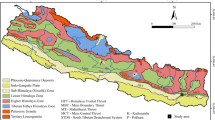Summary
-
1.
Nine fossil species of the Salicaceæ are described from leaf impressions among the material collected partly by R. R. Stewart in 1936 and partly by the author in 1940 from a few spots from the Ningal Nullah locality lying near Botapathri at an elevation of 9,000 ft. above sea-level; the strata are exposed on a wide grassy meadow on the right bank of Ningal Nullah stream. The fossiliferous beds belong to the Lower Karewa Series and are Pleistocene in Age.
-
2.
Of the nine species described in this paper there are four, namely,Salix Wallichiana, S. denticulata, Populus ciliata andP. nigra var.fastigiaia which are fully determined, the remaining five incompletely determined species include three belonging toSalix, which could not be identified specifically on account of the fragmentary nature of the plant material; and two distinct species ofPopulus, that do not seem to resemble any modern Himalayan species.
-
3.
All the fully determined species are represented in the modern flora of the Kashmir Valley, andSalix Wallichiana occurs at the present time in temperate parts of the Himalayas from Kurram Valley (alt. 10–12,000 ft.) through Kashmir to as far east as Garhwal (alt. 12,500 ft.), Nepal and Bhutan. It also occurs in moist places in the inner dry valleys of Pangi and Kagan.Salix denticulata is commonly found in the north-western Himalayas extending eastwards also like the first species, from the Kurram Valley to Western Nepal.Populus ciliata, the common Himalayan poplar, also grows in temperate regions between the altitudes of 4,000 and 10,000 ft., from the Kagan Valley through Kashmir to Bhutan.Populus nigra, var.fastigiata which is wild in Kabul is believed to be cultivated at the present time in the Western Himalayas up to the altitude of 12,500 ft.
-
4.
A comparison of the past and present distribution of the well determined fossil species, which are still growing in the Kashmir Valley near the fossiliferous region at the present time indicates that this part of the valley, at least, at one time during the Pleistocene had probably enjoyed a temperate climate essentially similar to modern climate of the valley, and this would have allowed the growth of temperate species likeJuglons regia,Rhamnus purpurea, Prunus cornuta, Pyrus Malus, Acer Cœsium, etc., all of which are the present as well as the past associates of the Salicaceæ.
-
5.
Though the terrestrial element of this flora as a whole does not indicate in clear terms that the uplift of the fossiliferous beds had taken place after their deposition, the presence among them of an aquatic element represented by a leaf fragment ofNelumbo nucifera, and some parallel-veined leaf fragments comparable to modern species ofSparganium andTypha, shows beyond doubt that the beds had been uplifted by the Pleistocene Himalayan Orogenies.
-
6.
While discussing the significance of temperate species in this flora it is pointed out that the other two floras discovered at Laredura and Liddarmarg indicate a prevalence in the valley, during the Pleistocene, of tropical or sub-tropical climate opposed to a cooler climate indicated by the Ningal Nullah species.
-
7.
The causes of the occurrence during the Pleistocene of three different floras on the northern slopes of the Pir Panjal Range of that time contemporaneously at three localities are also hinted at but a fuller discussion of this question is reserved for a later occasion.
Similar content being viewed by others
Bibliography
De Terra, H., and T. T. PatersonStudies on the Ice Age in India and Associated Human Cultures, Carnegie Institution, Washington, 1939.
Gamble, J. S.The Manual of Indian Timbers, London, 1902, 687–90.
Graham, R. Suggestions regarding the taxonomy and nomenclature of Cretaceous and Tertiary Plants,Journal of Palœontology, 1939,13, 124.
Parker, R. N.A Forest Flora for the Punjab with Hazara and Delhi, Lahore, 1918, 510.
Puri, G. S. Palæobotany in India, Progress Report for 1940,Journ. Ind. Bot. Soc., 1941,20, 7–8.
— Palæobotany in India, Progress Report for 1941, —, 1941,21, 222–24.
— The occurrence ofWoodfordia fruticosa (Linn.) S. Kurz. in the Karewa deposits of Kashmir, with remarks on changes of altitude and climate during the Pleistocene, —, 1943,22, 127–31.
-Puri, G. S. Note on a fossil leaf ofNelumbo nucifera Gäertn. from the Pleistocene (Karewa) deposits of Kashmir, with a review of the fossil history of the Nymphæaceæ,Palœobotany in India, V,Proc. Nat. Acad. Sci. Ind., 1944,14.
-The history of the Lombardy poplar (Populus nigra Linn., var.fastigiata Desf.) in India in the light of palæobotanical evidence,Indian Forrester (In the press), 1945.
Rendle, A. B.The Classification of Flowering Plants, Cambridge University Press, 1938, Vol. II, p. 9.
Stewart, J. L.The Forest Flora of the North-West and Central India, London, 1874, 472.
Author information
Authors and Affiliations
Additional information
Communicated by Prof. Birbal Sahni,f.a.sc., f.r.s.
Rights and permissions
About this article
Cite this article
Puri, G.S. Some fossil leaves of the salicace“ from Ningal Nullah and Laredura, Pir Panjal, with a note on the significance of temperate species in the Pleistocene flora of Kashmir. Proc. Indian Acad. Sci. 22, 87–112 (1945). https://doi.org/10.1007/BF03048769
Received:
Issue Date:
DOI: https://doi.org/10.1007/BF03048769



